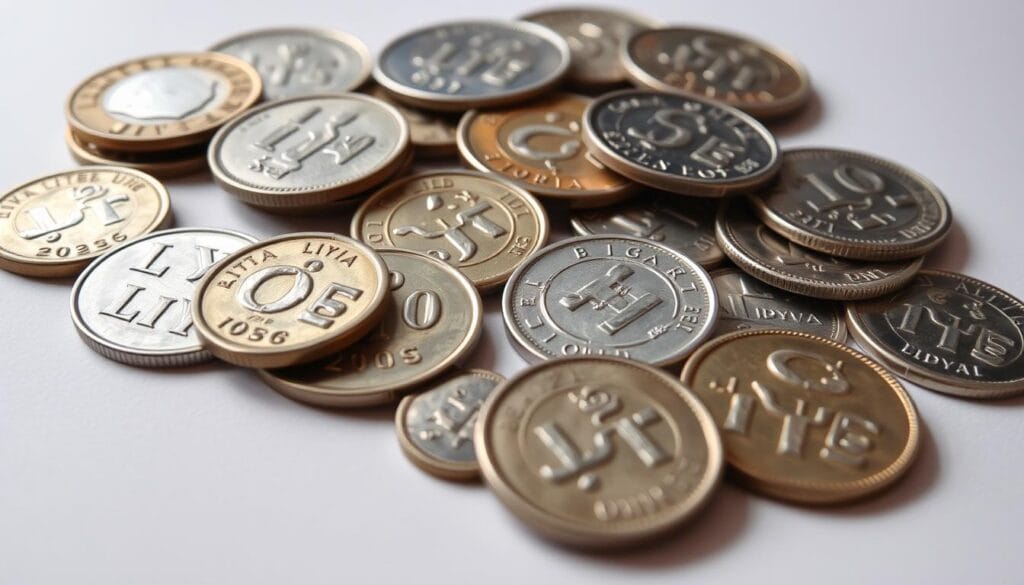
The Libyan Dinar (LYD) is Libya’s official currency. It was introduced in 1971, replacing the Libyan pound. The Libyan Dinar has a rich history and is issued by the Central Bank of Libya.
The Libyan Dinar is key for all transactions in Libya. It’s vital for anyone looking to exchange Libya money or do financial deals in the country. Knowing about the Libyan Dinar, including its coins and banknotes, is important for understanding Libya’s financial scene.
Key Takeaways
- The Libyan Dinar is the official currency of Libya.
- It was introduced in 1971, replacing the Libyan pound.
- The Central Bank of Libya is responsible for issuing the Libyan Dinar.
- The Libyan Dinar is used for all transactions within Libya.
- Understanding the Libyan Dinar is essential for financial transactions in Libya.
The Libyan Dinar: An Overview
Understanding the Libyan dinar is key to knowing Libya’s financial scene. The dinar shows the country’s economic health and stability.
Basic Facts About Libya’s National Currency
The Libyan dinar is split into 1,000 dirhams. The term “dirham” is not often used in daily life. But, it’s important for understanding the currency’s setup. The term “garsh” is used for 10 dirhams, making some transactions easier.
The Libyan dinar is marked by the symbol “LD” or “ل.د” in Arabic. This helps both Arabic and non-Arabic speakers recognize the currency.
The Libya Currency Code (LYD) and Symbol (ل.د)
The international code for the Libyan dinar is LYD, following ISO 4217 standards. This code is vital for international dealings, currency exchange, and financial reports. Locally, the symbol “ل.د” is a big part of Libya’s financial identity.
Here’s a table showing the Libyan dinar’s structure and use:
| Subdivision | Value in Dirhams | Equivalent in Dinars |
|---|---|---|
| 1 Dirhm | 1 | 0.001 LYD |
| 10 Dirhams (1 Garsh) | 10 | 0.01 LYD |
| 100 Dirhams | 100 | 0.1 LYD |
The Libyan dinar’s value has changed over time due to economic and political factors. Knowing these changes is important for anyone using the currency, whether for travel, business, or investments.
What Is Libya Currency: Understanding the Libyan Dinar
The Libyan Dinar is Libya’s main currency. It helps with buying and selling things, keeps track of money, and stores value.
Definition and Official Status
The Libyan Dinar is the official money in Libya. The Central Bank of Libya controls it, making sure it’s reliable. It replaced the Libyan pound in 1971, changing Libya’s money history.
Official Status: The Libyan Dinar is the only money accepted in Libya for all deals.
Subdivisions of the Libyan Dinar
The Libyan Dinar breaks down into 1,000 dirhams. You can find it in different amounts, like banknotes and coins. There are banknotes for 1, 5, 10, 20, and 50 dinars. Coins are for 50 and 100 dirhams, and even smaller amounts like ¼ and ½ dinars.
- Banknotes: 1, 5, 10, 20, 50 dinars
- Coins: 50, 100 dirhams; ¼, ½ dinars
This variety makes it easy to handle all kinds of money matters, big or small.
Historical Development of Libyan Currency
The history of Libya’s currency is complex. It was shaped by different periods of rule and occupation. Knowing this history helps us understand the Libyan Dinar today and its future.
From Ottoman Era to Italian Occupation
Libya’s currency story started in the Ottoman era. The Ottoman lira was used, showing Libya’s tie to the Ottoman Empire’s economy. In 1911, Italy took over, changing the currency to the Italian lira.
This change under Italian rule deeply affected Libya’s finances. The Italian lira brought Libya’s money system in line with Italy’s economic plans.
Post-Independence Currency Evolution
Libya became independent in 1951. It then had its own currency, the Libyan pound. In 1971, the Libyan Dinar replaced it, showing Libya’s economic growth.
The switch to the Dinar was key for Libya’s economic freedom. The Dinar was divided into 1,000 dirhams, making it strong for Libya’s economy.
Libya’s currency has evolved towards economic freedom and stability. Despite hurdles, the Libyan Dinar stands as a symbol of national pride and economic identity.
The Central Bank of Libya and Currency Management
The Central Bank of Libya is key to the country’s financial health. It manages the Libyan Dinar, keeping the currency stable and strong.
Role and Responsibilities of Libya’s Central Bank
The Central Bank of Libya has important jobs. It issues the Libyan Dinar, watches over banks, and controls credit. This helps keep the economy stable and growing.
Issuing currency is a big job for the bank. It designs and distributes Libyan Dinar, making sure they are secure and of high quality. The bank also checks on banks to keep the financial system safe.
Recent Challenges in Currency Governance
The Central Bank of Libya has faced big challenges. Political instability and conflict have made it hard to manage the Libyan Dinar. Different political groups have made it tough to agree on a single monetary policy.
The bank has also dealt with sanctions and the ups and downs of oil prices. Libya relies a lot on oil exports. These issues have made the Libyan Dinar’s value go up and down.
To tackle these problems, the Central Bank is making its currency management better. It’s working to stop counterfeiting, improve banknotes, and better supervise banks.
Libyan Dinar Banknotes: Designs and Security Features
The design and security of Libyan Dinar banknotes are key to stopping counterfeits. They keep the currency safe and sound.
Current Banknote Series and Denominations
The Libyan Dinar comes in different values: 1, 5, 10, 20, and 50 dinars. Each note shows off Libya’s culture and history in its own way.
The latest banknotes have cool designs. For example, the 50 Dinar banknote shows off a famous Libyan building. It highlights the country’s architectural wonders.
Anti-Counterfeiting Measures and Authentication
Libyan Dinar banknotes have top-notch security to fight counterfeits. They include:
- Watermarks: You can see these when you hold the note up to light.
- Holograms: These strips shine and look three-dimensional.
- Microprinting: It’s tiny text that’s hard to fake.
- Security Threads: These threads glow under UV light.
These features make the banknotes real and hard to fake. Knowing about them helps people check if a note is genuine.
Learning about Libyan Dinar banknotes shows how complex and advanced Libya’s money is.
Libyan Coins: Denominations and Designs
In Libya, coins come in different sizes, each with its own special design and history. These coins are a key part of the Libyan Dinar currency. They are used every day in the country.
Current Coin Series in Circulation
The coins you can find in Libya are in 50 and 100 dirhams, and ¼ and ½ dinars. These coins are not just for buying things. They also show off Libya’s culture and history through their designs.

Commemorative and Special Issue Coins
Libya also makes special coins for big events, anniversaries, or to honor important people in its history. These coins are loved by collectors. They add a special touch to Libya’s coin history.
The variety of Libyan coins makes the country’s currency more interesting. It connects people to Libya’s rich history and culture.
Libya Currency Exchange Rate and Value
Knowing the Libya currency exchange rate is key for those doing business or personal transactions across borders.
The Libyan Dinar’s worth changes based on its rate against the USD and EUR. This rate has seen big swings because of economic and political issues.
Current Exchange Rates Against USD and EUR
Here are the latest exchange rates for the Libyan Dinar against the USD and EUR:
| Currency | Exchange Rate (1 LYD = ) |
|---|---|
| USD | 0.24 |
| EUR | 0.22 |
These rates can change due to market conditions and economic signs.
Historical Exchange Rate Trends
The Libyan Dinar has seen big changes in value over time. Its rate has been influenced by Libya’s economy, like oil exports, and political stability.
- A big drop in the Dinar’s value during times of political trouble.
- Changes in response to global oil price shifts.
- Rate changes because of economic sanctions.
Knowing these trends helps predict future changes and make smart currency exchange choices.
The Dual Banking System in Libya
The Libyan banking sector has a unique setup. It combines traditional and Islamic banking. This mix offers a wide range of services, meeting various needs in the Libyan economy.
Libya’s banking system is flexible, thanks to both conventional and Islamic banking. Knowing how these systems work is key to understanding Libya’s financial scene.
Conventional Banking Practices
In Libya, conventional banking follows global standards. It provides services like deposits, loans, and trade finance. These banks are guided by the Central Bank of Libya’s rules.
Conventional banks in Libya offer different accounts and credit options. They also help with investments. They are important for Libya’s economy, supporting businesses and individuals.
Islamic Banking Principles and Implementation
Islamic banking in Libya sticks to Sharia law. It doesn’t allow interest. Instead, it uses Mudaraba and Musharaka for financing.
Islamic banking in Libya uses products like Islamic bonds (Sukuk) and Sharia-compliant funds. These products meet Islamic law while offering financial solutions.
The dual banking system in Libya shows the country’s effort to meet different financial needs. By offering both conventional and Islamic banking, Libya’s financial sector can serve more customers. This is true both at home and abroad.
Libya’s Economy and Its Impact on Currency Stability
The stability of the Libyan Dinar is closely tied to the country’s oil exports. This shows how the economy is vulnerable to changes in global oil prices. It’s important to understand Libya’s economy to see the challenges its currency faces.
Oil Dependency and Currency Fluctuations
Libya’s economy relies heavily on oil exports, which make up most of its income. This makes the economy and the Libyan Dinar very sensitive to oil price changes. When oil prices are high, the economy does well, and the Dinar gets stronger. But when oil prices fall, the economy struggles, and the Dinar’s value drops.
Impact of Oil Price Volatility:
- High oil prices: Strengthening of the Libyan Dinar
- Low oil prices: Depreciation of the Libyan Dinar

Economic Sanctions and Their Effects on the Dinar
Economic sanctions have also affected the Libyan Dinar’s value and stability. Sanctions can limit Libya’s oil exports, reducing government income and impacting the economy. This can cause the Dinar to lose value as more foreign currency is needed for imports.
| Economic Factor | Impact on Libyan Dinar |
|---|---|
| High Oil Prices | Strengthening |
| Low Oil Prices | Depreciation |
| Economic Sanctions | Depreciation |
In conclusion, the Libyan Dinar’s stability is influenced by several factors. These include the country’s oil dependence and the effects of economic sanctions. To improve the currency’s stability, Libya needs to diversify its economy and reduce the impact of sanctions.
Political Division and Its Effect on Libyan Currency
The political scene in Libya has been unstable, affecting its currency. The country is divided, leading to different currencies in the east and west.
This division has made managing the Libyan Dinar very hard. Different groups have their own Dinars, making a unified system hard to achieve. This situation impacts the currency’s stability and the economy as a whole.
Eastern vs. Western Dinar Issue
The east and west of Libya handle their currency differently. This has made financial transactions and currency exchange very challenging.
The table below shows the main differences between the eastern and western Dinars:
| Characteristics | Eastern Dinar | Western Dinar |
|---|---|---|
| Issuing Authority | Libya’s eastern government | Libya’s western government |
| Currency Circulation | Primarily in the eastern regions | Primarily in the western regions |
| Exchange Rate | Varies due to regional economic conditions | Varies due to regional economic conditions |
Efforts Toward Currency Unification
Despite the challenges, efforts to unify the Libyan Dinar continue. The Central Bank of Libya is working to stabilize the currency and restore its value.
They aim to standardize currency issuance and improve exchange rate stability. Unifying the currency is seen as key to economic stability in Libya.
Unifying the currency is a complex task that needs cooperation from all political groups in Libya. But, the benefits of a unified currency make these efforts worth it.
Practical Information for Travelers and Businesses
Traveling to or doing business in Libya? Knowing the local currency and financial services is key. Libya’s economy heavily relies on oil, so understanding the Libyan Dinar is vital.
Currency Exchange Tips for U.S. Visitors
U.S. visitors to Libya should check the current exchange rates. The Libyan Dinar is hard to find outside Libya, so exchanging it upon arrival is wise. It’s recommended to exchange enough for your first expenses. Credit cards are rare, so local currency is a must for shopping.
Banking and Money Transfer Services
Libya has a unique banking system with conventional and Islamic banks. Knowing these options helps with managing money. For sending money, Western Union is available in big cities.
| Banking Service | Description | Availability |
|---|---|---|
| Conventional Banking | Traditional banking services with interest rates. | Major cities |
| Islamic Banking | Sharia-compliant banking services without interest. | Major cities |
| Western Union | Money transfer service for sending and receiving. | Major cities |
| ATM Services | Availability of ATMs for cash withdrawal. | Limited |
Conclusion: The Future of Libya’s Currency
The Libyan Dinar’s future is linked to Libya’s economic and political stability. The country faces many economic challenges. These challenges will affect the value and stability of its currency.
Economic stability and political unity are key for the Libyan Dinar. The efforts to unify the currency are crucial. A stable and unified currency is vital for Libya’s growth.
The Libyan Dinar’s future looks bright if the country diversifies its economy and stays politically stable. Success in these areas will shape the dinar’s value. Watching these developments is important for the region’s economy.
FAQ
What is the official currency of Libya?
The official currency of Libya is the Libyan Dinar (LYD).
What is the symbol for the Libyan Dinar?
The symbol for the Libyan Dinar is “LD” or “ل.د” in Arabic.
What is the Libyan Dinar subdivided into?
The Libyan Dinar is subdivided into 1,000 dirhams.
Who issues the Libyan Dinar?
The Libyan Dinar is issued by the Central Bank of Libya.
What is the role of the Central Bank of Libya in managing the Libyan Dinar?
The Central Bank of Libya issues currency and regulates banks. It also works to maintain financial stability.
How has the value of the Libyan Dinar fluctuated over the years?
The Libyan Dinar’s value has changed due to Libya’s economy and politics. This includes oil dependency and economic sanctions.
What is the current status of the Libyan Dinar banknotes?
Today, Libyan Dinar banknotes have advanced security features. They come in various denominations to prevent counterfeiting.
Are there different types of Libyan coins?
Yes, Libya has many types of coins. This includes commemorative and special issue coins.
What is the Libya currency code?
The Libya currency code is LYD.
How does the dual banking system in Libya work?
Libya’s dual banking system offers both conventional and Islamic banking. This gives people and businesses more options.
What are the challenges facing the Libyan Dinar?
The Libyan Dinar faces challenges like political division and economic instability. It also needs currency unification.
How can travelers exchange currency in Libya?
Travelers can exchange currency at banks or currency exchange offices. They can also use ATMs. It’s important to know the current exchange rates and any fees.
What is the impact of economic sanctions on the Libyan Dinar?
Economic sanctions have made the Libyan Dinar’s value complicated. A diversified economy is needed to reduce these risks.
What are the efforts toward currency unification in Libya?
Libya is working to unify its currency. This aims to restore stability and legitimacy to the Libyan Dinar, solving the challenges of separate currencies.

Adam G
This post was created by Adam G, a seasoned financial writer with a passion for explaining currency exchange and market movements
